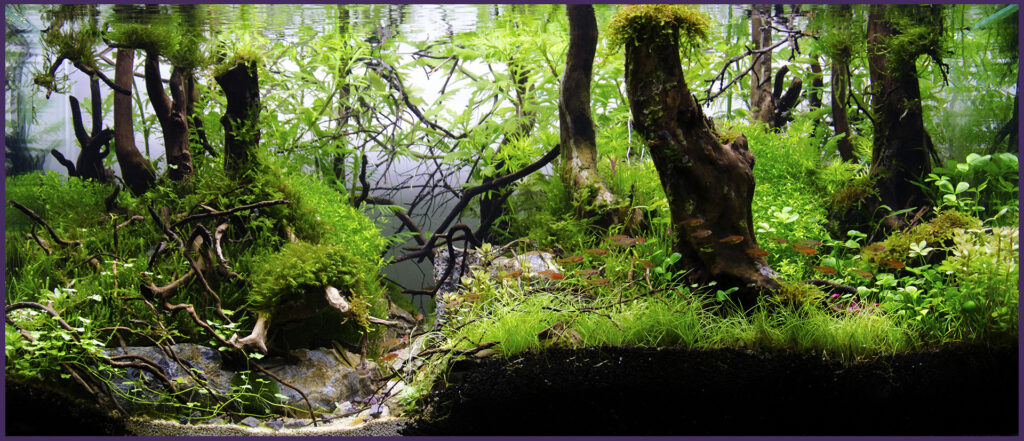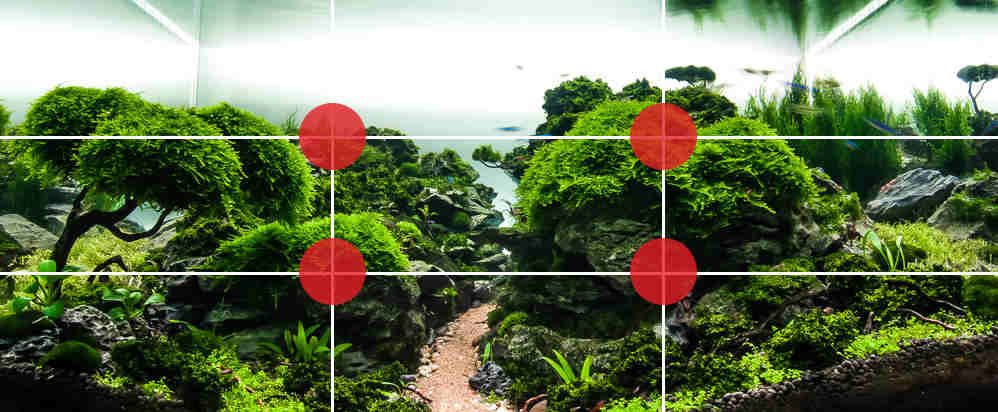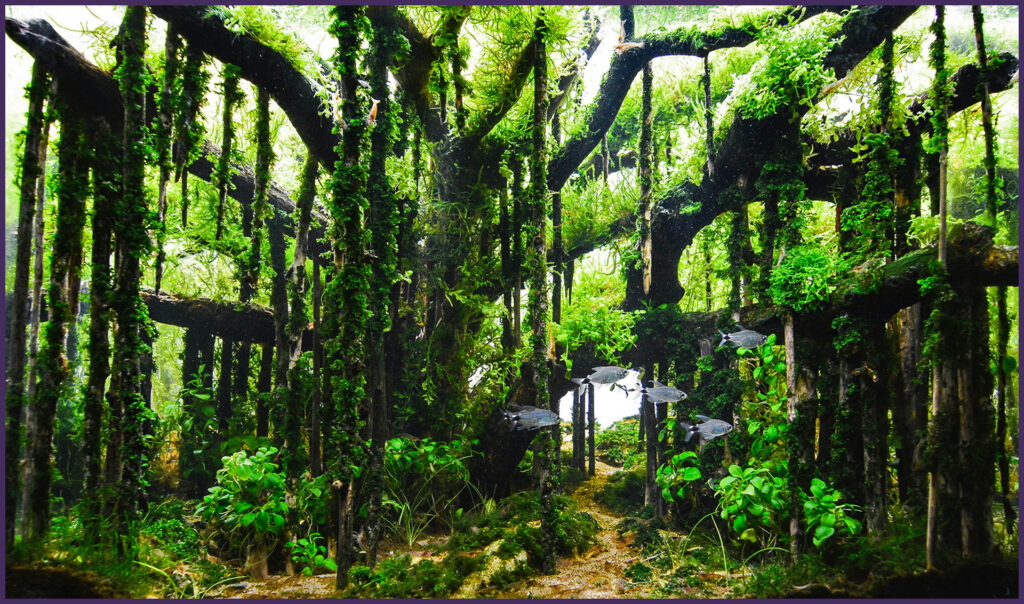Aquascaping is more than arranging plants and stones in a fish tank—it’s a vibrant blend of science, design, and personal expression. Like painting on a living canvas, it allows you to transform a simple glass box into an immersive slice of nature. But where do you begin? Whether you’re just starting out or refining your skills, the art of aquascaping welcomes everyone willing to learn, experiment, and be inspired.
Let’s dive into the essentials: the guiding principles, the tools of the trade, and the unique styles that make aquascaping a growing passion for hobbyists worldwide.

“Dream” Cave by Acho Choky
What Is Aquascaping?
Imagine an underwater garden, a lush aquatic world teeming with life and color. Aquascaping, at its core, is the creation of these submerged landscapes. It blends natural elements—plants, stones, driftwood, and substrate—into harmonious designs that mimic or reimagine nature
But aquascaping isn’t just about creating a pretty tank. It’s a craft that balances creativity with biology, science with artistry. It’s about curating a space where plants thrive, fish feel at home, and viewers are captivated.
Beyond the Basics: Why Aquascaping Matters
A beautifully aquascaped tank can evoke the same emotional response as a well-tended garden or a masterful painting. It provides a unique opportunity to connect with nature, even in the heart of a city. For many hobbyists, aquascaping becomes a therapeutic practice—a chance to unwind, focus, and create something meaningful.
Bringing the Outdoors In
When an aquascaped tank becomes part of your living space, it transforms into more than a hobby—it’s a centerpiece of creativity and conversation. Watching a well-designed tank is like stepping into a living diorama, each element contributing to a story. For many aquascapers, it’s about more than aesthetics; it’s a journey of discovery and expression.

“Habitat” by Jirawong Laopiyasakul
The Emotional Connection
Aquascaping often resonates on a deeper level. A tank can reflect personal stories or moments in nature that inspired you. From recreating a tranquil stream to imagining a fantastical underwater forest, your tank becomes an extension of your personality and artistic vision.
The Foundations of Aquascaping: Principles to Live By
Getting started with aquascaping can feel overwhelming, but like any art form, it’s built on fundamental principles. Mastering these allows you to create designs that are not only visually striking but also sustainable.
- Simplicity
Less is often more. Overloading your tank with too many plant species can result in visual chaos. Instead, focus on a few complementary elements that work together harmoniously.
- Variety
While simplicity is key, monotony can be dull. Use plants and materials with diverse shapes, sizes, and colors to create visual interest. Striking the right balance between simplicity and variety is the hallmark of a skilled aquascaper.
- Proportion
Think of your tank as a three-dimensional canvas. Balance open spaces with filled areas and use plants of different heights and textures to create depth and perspective. A good tip is to include foreground plants to anchor the tank’s design and taller background plants to frame the scene.
- Persistence
Aquascaping is a process of trial and error. Don’t be afraid to rearrange elements or start over if something doesn’t feel right. Each attempt brings you closer to mastering the craft.

“Lost River” by Yusuf Yıldız
The Tools of the Trade: Essential Equipment for Aquascaping
Creating an aquascaped tank requires more than plants and rocks. The right equipment helps ensure a healthy environment and supports your artistic vision.
Filters
Filters are the workhorses of any aquarium, keeping water clear and healthy by removing waste and debris. Choose a filter that matches the size of your tank and the needs of your aquascape.
Suggested Product: Canister filters are ideal for planted tanks, providing excellent mechanical and biological filtration to maintain crystal-clear water.
Lighting
Lighting isn’t just about showcasing your tank; it’s vital for plant growth. LED lights are a popular choice, offering customizable settings to mimic natural day and night cycles. Pay attention to light intensity and color temperature, as different plants have specific requirements.
Suggested Product: High-quality LED lights designed for aquascaping ensure vibrant plant growth and bring out the natural colors of your aquascape.
CO2 Systems
Plants need carbon dioxide to grow, and while fish produce some naturally, densely planted tanks often require additional CO2. A good system can be an investment, but it’s a game-changer for plant health.
Suggested Product: CO2 systems enhance plant growth and are perfect for aquascapers aiming to create lush, vibrant layouts.
Suggested product: A good CO2 system.
Fertilizers
Think of fertilizers as vitamins for your plants. Both macro- and micronutrients are essential to maintain healthy growth.
Suggested Product: Liquid fertilizers tailored for aquascaping ensure your plants receive the nutrients they need to thrive.
Substrate and Hardscape Materials
The foundation of any aquascape lies in its substrate and hardscape. Choose materials that support plant health while enhancing the visual appeal of your design. Experiment with layering different substrates to create depth and contrast.
Suggested Product: Aquascaping substrates like aquasoils provide essential nutrients for plant roots and help create a natural look.
Designing Your Aquascape: Rules of Composition
Great aquascapes don’t happen by accident. They follow the principles of visual design to guide the viewer’s eye and create a sense of balance.
The Rule of Thirds
Divide your tank into nine equal sections using two horizontal and two vertical lines. Place key elements at the intersections to create focal points that draw the eye.

The Rule of Thirds! Position key focal points at intersections for a balanced, natural, and visually striking aquarium.
The Golden Ratio
This mathematical principle has been used in art for centuries to create balanced compositions. In aquascaping, it helps determine the placement of major elements for maximum visual impact.
Creating Focal Points
Every aquascape needs one or more focal points—features that immediately catch the viewer’s attention. These can be dramatic rocks, clusters of colorful plants, or unique driftwood formations.
Enhancing Flow
Think of your aquascape as a living story. Elements like driftwood and rocks can guide the viewer’s eye along a path, creating a sense of motion or narrative within your design.
Exploring Aquascaping Styles
Aquascaping is an art, and like any art form, it comes with a variety of styles. Each has its own characteristics and challenges, allowing hobbyists to express their creativity in different ways.
The Dutch Aquarium
A celebration of plants, the Dutch style prioritizes vibrant, organized displays of aquatic vegetation. Hardscape materials are rarely used, with the focus entirely on terraced plant arrangements.
Iwagumi: Japanese Zen
Inspired by traditional Japanese rock gardens, Iwagumi designs emphasize simplicity and balance. They use a small number of rocks as the main feature, complemented by low-growing plants.
The Nature Aquarium
Introduced by Takashi Amano, this style mimics natural landscapes like forests or mountains. It’s a blend of plants and hardscape elements, often creating dramatic, lifelike scenes.
The Jungle Style
For those who prefer a wild, untamed look, the Jungle style is less structured but equally captivating. It allows plants to grow freely, creating a lush, overgrown appearance.

“Jungle” by Hsu Hung Hsiao. A good example of a jungle style acuascape.
Tips for Achieving Depth and Perspective
Depth is what transforms a two-dimensional layout into a three-dimensional masterpiece. Use these tips to create a sense of scale and immersion in your tank.
Choose the Right Background
Gradient-colored backgrounds or frosted glass can enhance the illusion of depth.
Balance Foreground, Midground, and Background
Combine low-growing plants, mid-height features, and tall background elements to create layers.
Use Natural Substrates
Opt for substrates that blend with your tank’s theme, like fine sand or gravel.
Vary Plant Sizes and Colors
Use a mix of plants to create contrast and draw the eye across the tank.
Choosing Fish for Your Aquascape
The fish you choose can make or break your aquascape. Opt for species that complement the design and won’t disturb plants or hardscape elements. Small, schooling fish like tetras or rasboras are ideal for creating a dynamic, colorful display.
Suggested Product: Aquarium-safe plant fertilizer helps maintain a healthy balance for both plants and fish.
Further reading and images:
RFLAC yearly aquascape contest, check out the galleries
Aquascaping by Takasi Amano Article by Le Journal Aqua
How to Set Up Your Very First Freshwater Aquarium: A Step-by-Step Guide
